When Legacy accepted the generous donation of 51 acres of farmland, oak hickory forest, and buttonbush swamp from the Lloyd & Mabel Johnson Foundation in 2007, we established a management plan for the preserve to outline our vision and guide our actions. The agricultural fields were a new adventure; while we had conserved hundreds of acres of farmland through conservation easements, we had not yet owned and managed that type of land use. To give ourselves some time to make decisions about the future of that land carefully, we opted to maintain the relationship with the farmer who was already leasing and farming it (it’s easier to restore farmland than fallow open land). We poured energy into woodland and trails until we had the bandwidth to begin exploring next steps for the farm fields.
Farmland loss has been exponential in most areas of the US and southeast Michigan is no exception, so the first options we explored all strove to keep that farmland in production. In 2016 we developed a Request for Proposals (RFP) in hopes that our resource ‒18 acres of open cropland ‒ would overlap with a small-scale farmer in need of a place to start or grow their business. We reached out to Tilian Farm Development Center, and dispersed our RFP as widely as possible. The dream was to transition from modern row-cropping to a more “sustainable” method, while also giving a new and beginning or socially disadvantaged farmer a place to sink in their roots.
But, when our RFP and direct inquiries didn’t produce an interested producer (turns out 18 acres is a lot for a new and beginning farmer when it comes without infrastructure like barns and water on site), we began exploring options for converting the cropland to habitat.
Front and center in this kind of work is the Natural Resources Conservation Service’s Conservation Reserve Program. Legacy was able to enter the Johnson Preserve into this program, which provides technical and financial support for establishing prairies/grasslands on farmland that landowners wish to retire. A seed mix was chosen based on the site’s soil profile and hydrologic conditions. A chronic problem in these fields had been flooding and significant ponding, so we acknowledged the need for species to happily occupy seasonal wet depressions. With this in mind, we settled on a seed mix that included species from dry-mesic and wet-mesic prairie types, knowing that different species would take root where their conditions were right.
In May of 2017, after much paperwork and preparation, we contracted with Native Connections, based in southwest Michigan, to install the prairie. Native Connections brought with them a tractor-mounted seed drill. An extremely useful and effective tool, the seed drill does just what its name suggests: deposits tiny seeds just below the soil surface, distributing them evenly along its path. “Drilling” the seed can increase the overall success of the planting, and the compacted soils of the Johnson Preserve’s farmland needed all the help they could get.
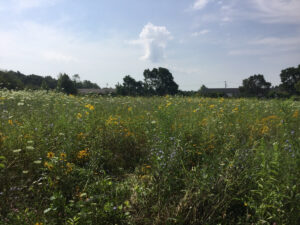
View of farmland turned prairie at Johnson Preserve in 2019 (during the second year of establishment)
As we’ve shared in recent articles, some of the previously farmed acreage supports prairie restoration research piloted by Eastern Michigan University professor Emily Grman, and some houses gardens operated by Project Grow Community Gardens. But what about the remaining 15 acres?
Prairie restorations are pretty universally acknowledged to take about three years to become truly established. It’s a watching and waiting game. We were urged to be patient as we saw some early-successional non-native plants occupying the prairie space; with time the native species we planted would take hold.
And they have! Walking through the prairie now, one can see the tall and distinctive seedheads of several native grasses swaying in the breeze: big bluestem, Indian grass, switchgrass, and Canada and Virginia wild rye. Many forbs (wildflowers) are slower to establish, but some hearty species like yellow coneflower, black-eyed Susan, and New England aster showed up within the first and second years. In the third year, wild senna and blue vervain added their faces to the fields. And now, in the prairie’s fourth official growing season, we’re seeing golden Alexanders, sneezeweed, foxglove beardtongue, and rattlesnake master (listed as Threatened in Michigan). Marsh blazingstar, wool grass, and fox sedge grow near the wetter areas, along with a whole host of rushes which we didn’t plant, but are welcome nonetheless. In the wettest field, the community is quite distinct, with a thriving population of water plantain. Of course, we continue to manage invasive plants like Canada thistle, teasel, sweet clover, and black locust, and will conduct a burn on a portion of the prairie in the spring of 2021 (prairies really like to burn).
With the greater diversity in plant life have come birds and insects, and while we haven’t yet undergone any type of inventory work to quantify the change, a walk through the prairie provides a good preliminary measure: there is life here, where before, there was less.
To showcase this work, we’ve re-routed the trail (updated trail map forthcoming) to allow visitors full access to the maturing prairie. While our three-year “establishment” window might have closed, this ecosystem will continue to grow and change. The site’s heavily compacted soils will change as native species become more established, not to mention changes in our local and regional climate patterns. We hope you’ll walk the prairie trail, and join us in watching the show.
If you are interested in learning more about our process, or about the Conservation Reserve Program that allowed us to do this work, we’re happy to share! Contact Land Stewardship Coordinator Allene Smith for more information.
Click here for more beautiful photos of the Johnson Preserve prairie by John Metzler

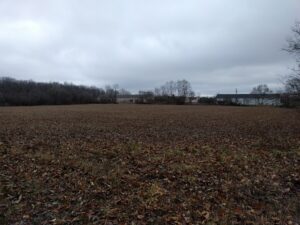

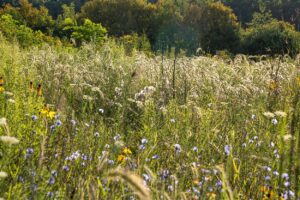
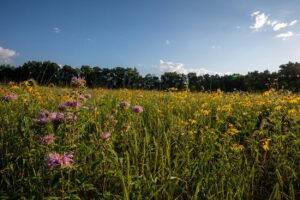
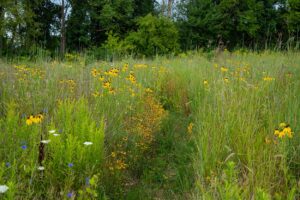
 RSS Feed
RSS Feed
Where is the Johnson Preserve and is there a map showing the trails?
The Preserve is in Ann Arbor on the east side of Platt Road, south of Ellsworth Road, with a dedicated parking area just north of 4595 Platt Road. (south of the south entrance to Lillie Park) A trail map can be found here – https://legacylandconservancy.org/preserves/legacy-preserves/lloyd-mabel-johnson-preserve/